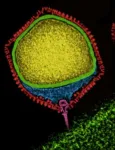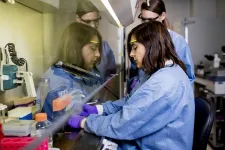NIH study suggests using cannabis while trying to conceive may reduce pregnancy chances
2021-01-11
(Press-News.org) Women who use marijuana could have a more difficult time conceiving a child than women who do not use marijuana, suggests a study by researchers at the National Institutes of Health. Marijuana use among the women's partners--which could have influenced conception rates--was not studied. The researchers were led by Sunni L. Mumford, Ph.D., of the Epidemiology Branch in NIH's Eunice Kennedy Shriver National Institute of Child Health and Human Development. The study appears in Human Reproduction.
The women were part of a larger group trying to conceive after one or two prior miscarriages. Women who said they used cannabis products--marijuana or hashish--in the weeks before pregnancy, or who had positive urine tests for cannabis use, were around 40% less likely to conceive per monthly cycle than women who did not use cannabis. The authors noted that although the findings suggest cannabis could affect women's fertility, they should be tempered with caution as the study observed a relatively small number of cannabis users. However, the authors say their results suggest that women trying to conceive should exercise caution with cannabis use until more definitive evidence is available.
The researchers analyzed data from a broader study of more than 1,200 women ages 18 to 40 with one or two pregnancy losses. The women participated in the study for up to six monthly cycles while attempting pregnancy and throughout pregnancy if conception occurred. After enrolling in the study, the women responded to a questionnaire asking if they had used marijuana, pot, or hashish in the past 12 months, with responses ranging from never, rarely, occasionally, sometimes, often, to daily. Each woman also provided urine samples for analysis when they first entered the study and after six months if they did not conceive or at the time of positive pregnancy test if they conceived.
A total of 62 women (5%) either had a positive urine test or responded that they had used cannabis before conception.
For each monthly cycle, women who had used cannabis while trying to conceive were 41% less likely to conceive than non-users. Similarly, a smaller proportion of cannabis users than non-users became pregnant during the study--42% versus 66%. The authors found no differences in miscarriage rates between users and non-users who had achieved pregnancy.
The authors noted that, compared to non-users, cannabis users also had differences in reproductive hormones involved in ovulation. These differences could potentially have influenced their likelihood of conception. Specifically, users had higher levels of luteinizing hormone and a higher proportion of luteinizing hormone to follicle stimulating hormone.
The authors also noted that animal studies had found that cannabis use could alter the lining of the uterus, making it less likely an embryo to implant and establish a pregnancy. Until more information is available, the authors said, women trying to become pregnant should be aware that cannabis could potentially affect their pregnancy chances.
INFORMATION:
Reference
Mumford SL et al. Cannabis use while trying to conceive: a prospective cohort study evaluating associations with fecundability, live birth, and pregnancy loss. Human Reproduction. 2020.
doi:10.1093/humrep/deaa355
The paper can be found online after publication at:
https://academic.oup.com/humrep/article-lookup/doi/10.1093/humrep/deaa355
About the Eunice Kennedy Shriver National Institute of Child Health and Human Development (NICHD): NICHD leads research and training to understand human development, improve reproductive health, enhance the lives of children and adolescents, and optimize abilities for all. For more information, visit https://www.nichd.nih.gov.
About the National Institutes of Health (NIH): NIH, the nation's medical research agency, includes 27 Institutes and Centers and is a component of the U.S. Department of Health and Human Services. NIH is the primary federal agency conducting and supporting basic, clinical, and translational medical research, and is investigating the causes, treatments, and cures for both common and rare diseases. For more information about NIH and its programs, visit https://www.nih.gov.
ELSE PRESS RELEASES FROM THIS DATE:
2021-01-11
Scientists have used a "galaxy-sized" space observatory to find possible hints of a unique signal from gravitational waves, or the powerful ripples that course through the universe and warp the fabric of space and time itself.
The new findings, which appeared recently in The Astrophysical Journal Letters, hail from a U.S. and Canadian project called the North American Nanohertz Observatory for Gravitational Waves (NANOGrav).
For over 13 years, NANOGrav researchers have pored over the light streaming from dozens of pulsars spread throughout the Milky ...
2021-01-11
Nothing in biology is static. Biological processes fluctuate over time, and if we are to put together an accurate picture of cells, tissues, organs etc., we have to take into account their temporal patterns. In fact, this effort has given rise to an entire field of study known as "chronobiology".
The liver is a prime example. Everything we eat or drink is eventually processed there to separate nutrients from waste and regulate the body's metabolic balance. In fact, the liver as a whole is extensively time-regulated, and this pattern is orchestrated by the so-called ...
2021-01-11
EAST LANSING, Mich. - Michigan State University is leading a global research effort to offer the first worldwide view of how climate change could affect water availability and drought severity in the decades to come.
By the late 21st century, global land area and population facing extreme droughts could more than double -- increasing from 3% during 1976-2005 to 7%-8%, according to Yadu Pokhrel, associate professor of civil and environmental engineering in MSU's College of Engineering, and lead author of the research published in Nature Climate Change.
"More and more people will suffer from extreme droughts if a medium-to-high level of global warming ...
2021-01-11
Researchers at Columbia University Mailman School of Public Health developed an infectious disease early warning system that includes areas lacking health clinics participating in infectious disease surveillance. The approach compensates for existing gaps by optimally assigning surveillance sites that support better observation and prediction of the spread of an outbreak, including to areas remaining without surveillance. Details are published in the journal Nature Communications.
The research team, including Jeffrey Shaman and Sen Pei, have been at the forefront of forecasting and analyzing the spread of COVID-19. Their ...
2021-01-11
Fast facts:
This study describes essential differences between marine and freshwater species and the contributions of viruses to such differences
The results may help guide future bioengineering efforts to develop plant strains adapted to grow in salt-water, which is of local and regional food security interest
Microalgae are fundamental to global ecosystems due to their ability to sustain coral reef species and produce atmospheric oxygen
Before this study, many important algal phyla did not have sequenced representatives
Viruses have contributed to the evolution of algae and their genome makeups
Abu Dhabi, UAE, January 11, 2021: NYU Abu Dhabi (NYUAD) ...
2021-01-11
It is well known that the expansion of the universe is accelerating due to a mysterious dark energy. Within galaxies, stars also experience an acceleration, though this is due to some combination of dark matter and the stellar density. In a new study to be published in Astrophysical Journal Letters researchers have now obtained the first direct measurement of the average acceleration taking place within our home galaxy, the Milky Way. Led by Sukanya Chakrabarti at the Institute for Advanced Study with collaborators from Rochester Institute of Technology, University of Rochester, and ...
2021-01-11
Moms are not more likely than other women to support gun control efforts. In fact, a new study finds that parenthood doesn't have a substantial effect on the gun control views of men or women.
"Everybody 'knows' that moms are more politically liberal on gun control issues," says Steven Greene, corresponding author of the study and a professor of political science at North Carolina State University. "We wanted to know if that's actually true. And, as it turns out, it's not true - which was surprising."
To explore the impact of parenthood on people's gun control views, the researchers drew on data collected by the Pew Center for Research in 2017 as part of Pew's nationally ...
2021-01-11
Lithium-ion batteries are critical for modern life, from powering our laptops and cell phones to those new holiday toys. But there is a safety risk - the batteries can catch fire.
Zinc-based aqueous batteries avoid the fire hazard by using a water-based electrolyte instead of the conventional chemical solvent. However, uncontrolled dendrite growth limits their ability to provide the high performance and long life needed for practical applications.
Now researchers have reported in Nature Communications that a new 3D zinc-manganese nano-alloy anode has overcome the limitations, resulting in a stable, high-performance, dendrite-free aqueous battery using seawater ...
2021-01-11
In diseases characterized by bone loss -such as periodontitis, rheumatoid arthritis, and osteoporosis- there is a lot that scientists still don't understand. What is the role of the immune response in the process? What happens to the regulatory mechanisms that protect bone?
In a paper published recently in Scientific Reports, researchers from the Forsyth Institute and the Universidad de Chile describe a mechanism that unlocks a piece of the puzzle. Looking at periodontal disease in a mouse model, scientists found that a specific type of T cell, known as regulatory T cells, start behaving in unexpected ways. These cells lose their ability to regulate bone ...
2021-01-11
WASHINGTON -- As LEDs replace traditional lighting systems, they bring more smart capabilities to everyday lighting. While you might use your smartphone to dim LED lighting at home, researchers have taken this further by tapping into dynamically controlled LEDs to create a simple illumination system for 3D imaging.
"Current video surveillance systems such as the ones used for public transport rely on cameras that provide only 2D information," said Emma Le Francois, a doctoral student in the research group led by Martin Dawson, Johannes Herrnsdorf and Michael Strain at the University of Strathclyde in the ...
LAST 30 PRESS RELEASES:
[Press-News.org] NIH study suggests using cannabis while trying to conceive may reduce pregnancy chances




